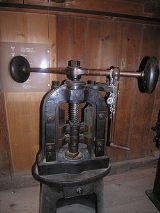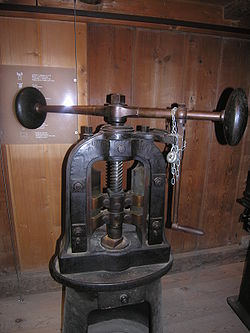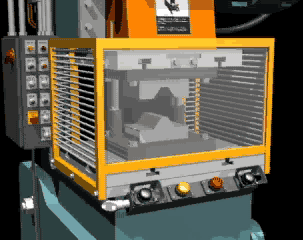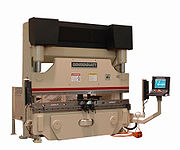
Machine press
Encyclopedia


Machine tool
A machine tool is a machine, typically powered other than by human muscle , used to make manufactured parts in various ways that include cutting or certain other kinds of deformation...
that changes the shape of a workpiece.
Servomechanism
A servomechanismServomechanism
thumb|right|200px|Industrial servomotorThe grey/green cylinder is the [[Brush |brush-type]] [[DC motor]]. The black section at the bottom contains the [[Epicyclic gearing|planetary]] [[Reduction drive|reduction gear]], and the black object on top of the motor is the optical [[rotary encoder]] for...
press, also known as a servo press or a electro press, is a press driven by an AC
Alternating current
In alternating current the movement of electric charge periodically reverses direction. In direct current , the flow of electric charge is only in one direction....
servo motor. The torque
Torque
Torque, moment or moment of force , is the tendency of a force to rotate an object about an axis, fulcrum, or pivot. Just as a force is a push or a pull, a torque can be thought of as a twist....
produced is converted to a linear force
Force
In physics, a force is any influence that causes an object to undergo a change in speed, a change in direction, or a change in shape. In other words, a force is that which can cause an object with mass to change its velocity , i.e., to accelerate, or which can cause a flexible object to deform...
via a ball screw
Ball screw
A ball screw is a mechanical linear actuator that translates rotational motion to linear motion with little friction. A threaded shaft provides a helical raceway for ball bearings which act as a precision screw. As well as being able to apply or withstand high thrust loads, they can do so with...
. Pressure and position are controlled though a load cell
Load cell
A load cell is a transducer that is used to convert a force into electrical signal. This conversion is indirect and happens in two stages. Through a mechanical arrangement, the force being sensed deforms a strain gauge. The strain gauge measures the deformation as an electrical signal, because the...
and an encoder
Encoder
An encoder is a device, circuit, transducer, software program, algorithm or person that converts information from one format or code to another, for the purposes of standardization, speed, secrecy, security, or saving space by shrinking size.-Media:...
. The main advantage of a servo press is its low energy consumption; its only 10-20% of other press machines. Another advantage is a quiet and clean work environment.
Shop press
A simple frame, fabricatedFabrication (metal)
Fabrication as an industrial term refers to building metal structures by cutting, bending, and assembling. The cutting part of fabrication is via sawing, shearing, or chiseling ; torching with handheld torches ; and via CNC cutters...
from steel, containing a bottle jack or simple hydraulic cylinder. Good for general-purpose work in the auto mechanic shop, machine shop, garage or basement shops, etc. Typically 1 to 30 tons of pressure, depending on size and expense. Classed with engine hoists
Hoist (device)
A hoist is a device used for lifting or lowering a load by means of a drum or lift-wheel around which rope or chain wraps. It may be manually operated, electrically or pneumatically driven and may use chain, fiber or wire rope as its lifting medium. The load is attached to the hoist by means of a...
and engine stand
Engine stand
An engine stand is a tool commonly used to repair large heavy gasoline or diesel engines. It uses a heavy cantilevered support structure to hold the engine in midair so that the mechanic has access to any exposed surface of the engine....
s in many tool catalogs.
Forging press
A forging press reforms the work piece into a three dimensionalDimension
In physics and mathematics, the dimension of a space or object is informally defined as the minimum number of coordinates needed to specify any point within it. Thus a line has a dimension of one because only one coordinate is needed to specify a point on it...
object—not only changing its visible shape but also the internal structure of the material. A stronger part results from this process than if the object was machined
Machining
Conventional machining is a form of subtractive manufacturing, in which a collection of material-working processes utilizing power-driven machine tools, such as saws, lathes, milling machines, and drill presses, are used with a sharp cutting tool to physical remove material to achieve a desired...
.
Press brake

Rolling press
A rolling press has a set of rollers used to thin sheet metalSheet metal
Sheet metal is simply metal formed into thin and flat pieces. It is one of the fundamental forms used in metalworking, and can be cut and bent into a variety of different shapes. Countless everyday objects are constructed of the material...
. The sheet metal is fed into the rollers, which are turning, and the sheet is pulled through. The space between the rollers is smaller than the starting sheet metal thickness, therefore the metal is made thinner and/or wider.
Stamping press
A stamping press is a machine press used to shape or cut metal by deforming it with a dieDie (manufacturing)
A die is a specialized tool used in manufacturing industries to cut or shape material using a press. Like molds, dies are generally customized to the item they are used to create...
. It generally consists of a press frame, a bolster plate, and a ram.
Others
Another kind of press is a set of plates with a relief, or depth-based design, in them. The metal is placed between the plates, and the plates are pressed up against each other, deforming the metal in the desired fashion. This may be coiningCoining (machining)
Coining is a form of precision stamping in which a workpiece is subjected to a sufficiently high stress to induce plastic flow on the surface of the material. A beneficial feature is that in some metals, the plastic flow reduces surface grain size, and work hardens the surface, while the material...
or embossing or forming.
Capping presses form caps from rolls of aluminium
Aluminium
Aluminium or aluminum is a silvery white member of the boron group of chemical elements. It has the symbol Al, and its atomic number is 13. It is not soluble in water under normal circumstances....
foil at up to 660 per minute.
Comparison
| Type of press | Type of frame | Position of frame | Action | Method of actuation | Type of drive | Suspension | Ram | Bed | ||||||||||||||||||||||||||
| Open-back | Gap | Straight-side | Arch | Piller | Solid | Tie rod | Vertical | Horizontal | Inclinable | Inclined | Single | Double | Triple | Crank | Front-to-back crank | Eccentric | Toggle | Screw | Cam | Rack & pinion | Piston | Over direct | Geared, overdrive | Under direct | Geared, underdrive | One-point | Two-point | Four-point | Single | Multiple | Solid | Open | Adjustable | |
| Bench | X | X | X | X | X | X | X | X | X | X | X | X | X | X | X | X | X | X | ||||||||||||||||
|---|---|---|---|---|---|---|---|---|---|---|---|---|---|---|---|---|---|---|---|---|---|---|---|---|---|---|---|---|---|---|---|---|---|---|
| Open-back inclinable | X | X | X | X | X | X | X | X | X | X | X | X | X | X | X | X | X | X | ||||||||||||||||
| Gap-frame | X | X | X | X | X | X | X | X | X | X | X | X | X | X | X | X | X | X | X | X | X | X | X | X | ||||||||||
| Adjustable-bed horn | X | X | X | X | X | X | X | X | X | X | X | X | X | X | X | |||||||||||||||||||
| End-wheel | X | X | X | X | X | X | X | X | X | X | X | X | ||||||||||||||||||||||
| Arch-frame | X | X | X | X | X | X | X | X | X | X | X | X | ||||||||||||||||||||||
| Straight-side | X | X | X | X | X | X | X | X | X | X | X | X | X | X | X | X | X | X | X | X | X | X | X | X | X | X | ||||||||
| Reducing | X | X | X | X | X | X | X | X | X | X | X | X | X | X | X | |||||||||||||||||||
| Knuckle-lever | ||||||||||||||||||||||||||||||||||
| Toggle-draw | ||||||||||||||||||||||||||||||||||
| Cam-drawing | ||||||||||||||||||||||||||||||||||
| Two-point single-action | ||||||||||||||||||||||||||||||||||
| High-production | ||||||||||||||||||||||||||||||||||
| Dying machine | ||||||||||||||||||||||||||||||||||
| Transfer | ||||||||||||||||||||||||||||||||||
| Flat-edge trimming | ||||||||||||||||||||||||||||||||||
| Hydraulic | ||||||||||||||||||||||||||||||||||
| Press brake | ||||||||||||||||||||||||||||||||||
History
Historically, metal was shaped by hand using a hammerHammer
A hammer is a tool meant to deliver an impact to an object. The most common uses are for driving nails, fitting parts, forging metal and breaking up objects. Hammers are often designed for a specific purpose, and vary widely in their shape and structure. The usual features are a handle and a head,...
. Later, larger hammers were constructed to press more metal at once, or to press thicker materials. Often a smith would employ a helper or apprentice to swing the sledgehammer
Sledgehammer
A sledgehammer is a tool consisting of a large, flat head attached to a lever . The head is typically made of metal. The sledgehammer can apply more impulse than other hammers, due to its large size. Along with the mallet, it shares the ability to distribute force over a wide area...
while the smith concentrated on positioning the workpiece. Adding windmill
Windmill
A windmill is a machine which converts the energy of wind into rotational energy by means of vanes called sails or blades. Originally windmills were developed for milling grain for food production. In the course of history the windmill was adapted to many other industrial uses. An important...
or steam
Steam
Steam is the technical term for water vapor, the gaseous phase of water, which is formed when water boils. In common language it is often used to refer to the visible mist of water droplets formed as this water vapor condenses in the presence of cooler air...
power yielded still larger hammers such as steam hammer
Steam hammer
A steam hammer is a power-driven hammer used to shape forgings. It consists of a hammer-like piston located within a cylinder. The hammer is raised by the pressure of steam injected into the lower part of a cylinder and falls down with a force by removing the steam. Usually, the hammer is made to...
s. Most modern machine presses use a combination of electric motors and hydraulics to achieve the necessary pressure. Along with the evolution of presses came the evolution of the dies
Die (manufacturing)
A die is a specialized tool used in manufacturing industries to cut or shape material using a press. Like molds, dies are generally customized to the item they are used to create...
used within them.
Safety
Machine presses can be hazardous, so safety measures must always be taken. Bi-manual controls (controls the use of which requires both hands to be on the buttons to operate) are a very good way to prevent accidents, as are light sensors that keep the machine from working if the operator is in range of the die.External links
- ISGEC presses

